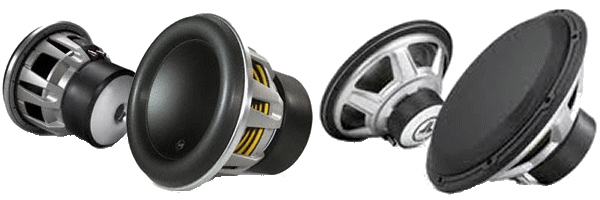Speaker Driver Displacement Calculator Help
Use the Driver Displacement Calculator.
This calculator provides a rough approximation of the volume taken up by the speaker driver inside your custom built speaker box. The more information you provide the more accurate the approximation will be. Use this calculator with our Speaker Designer to determine the correct speaker box volume and Speaker Volume Calculator to determine the speaker box dimensions to achieve that volume.
Note: This calculator is not and cannot be completely accurate. It makes guesses about the properties of your driver and only accounts for the cone and magnet volume and ignores everything else. Still, in testing it against many drivers found on-line that do provide Driver Displacement data, this calculator appears to be accurate to within 20%.
Here are the variables used to determine the speaker driver displacement.

Effective Cone Diameter: This is the width of the moving part of the driver. It is not the advertised speaker width. It is usually provided in the speaker specifications.
Mounting Depth: This is the distance from the back of the magnet to the back of the mounting surface on the front of the driver. This is also usually provided in the speaker specifications. Your speaker box must be at least this deep to fit the driver.
Magnet Diameter: This is the width of the magnet at the bottom of the driver. It may be provided in the speaker specifications. If not, use a ruler to measure it.
Magnet Height: This is the height of the magnet. It may be provided in the speaker specifications. If not, use a ruler to measure it.
One Way, Linear Excursion (xmax): This is the maximum distance that the cone can travel outward when provided with a signal. It should be provided in the speaker specifications. This calculator assumes that this Xmax distance is the same distance that the driver can travel inward, and therefore is a rough approximation of the distance between the magnet and the cone at rest. If Xmax is not provided, then try to measure the distance between the top magnet and the back of the cone.
Front Baffle Thickness: The thickness of the wood that the speaker is mounted to.
Flush Mount: Is the speaker flush mounted to the front baffle? Did you router out a notch around the hole to allow the driver to be flush with the front of the speaker box?
Desired Output Unit: What unit do you want the volume to be displayed in?
When determining the dimensions of the speaker box you must account for internal bracing and driver displacement. The volume of the box should be the based on the calculated necessary volume + the volume taken up by internal bracing + the volume taken up by the speaker itself. This calculator helps you determine the volume taken up by the speaker if your manufacturer did not provide this information.
Note: Some manufacturers will provide suggested box volumes or even the exact dimensions of the speaker box. Sometimes, the manufacturer has already accounted for speaker displacement in these suggested values. If this is the case then you do not need to use this tool. Enter a speaker displacement value of 0 in the Speaker Volume Calculator.
The simplest form of this calculator is:
Speaker Driver Displacement = 3.14 * (Effective Cone Diameter / 2)2 * Mounting Depth / 3
This is the formula for a cone whose height is the height of the speaker and the width is the diameter of the speaker. From this displacement the calculator will subtract the volume of wood that will be cut from the front baffle - which is why the front baffle thickness is needed. This thickness is reduced if the speaker is flush mounted. A 1/4" flush mount depth is assumed.
This simple calculator assumes all speakers are generally similar. This is obviously no the case. Look at the two 12" woofers below. The huge magnet on the one on the left will displace much more air than the speaker on the right. The speaker box for the woofer on the left must be bigger.

This calculator can do a much better job if it is provided with the magnet height & diameter and the Xmax values. The Speaker Driver Displacement Calculator will then add the magnet volume (using the formula for a cylinder):
Magnet Volume = 3.14 * (Magnet Diameter / 2)2 * Magnet Height
to the displacement of the cone (using the formula for a cone):
Cone Volume = 3.14 * (Effective Cone Diameter / 2)2 * (Mounting Depth - Magnet Height - Xmax) / 3
and will subtract out the volume of the front baffle as discussed above.